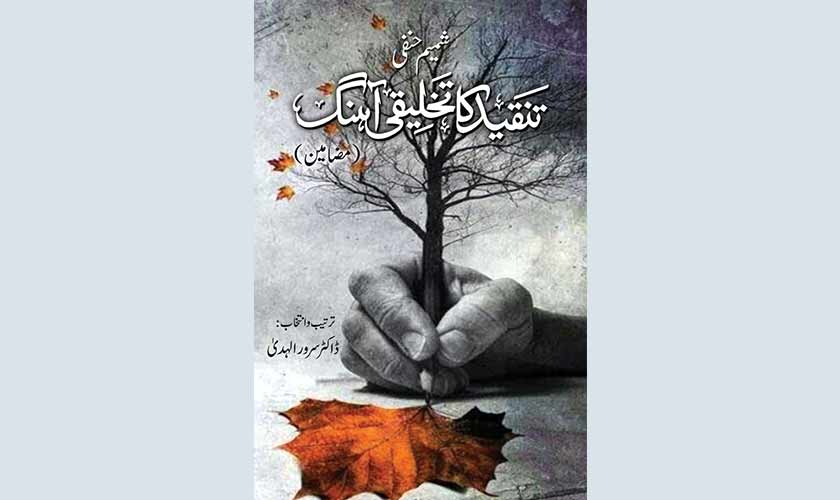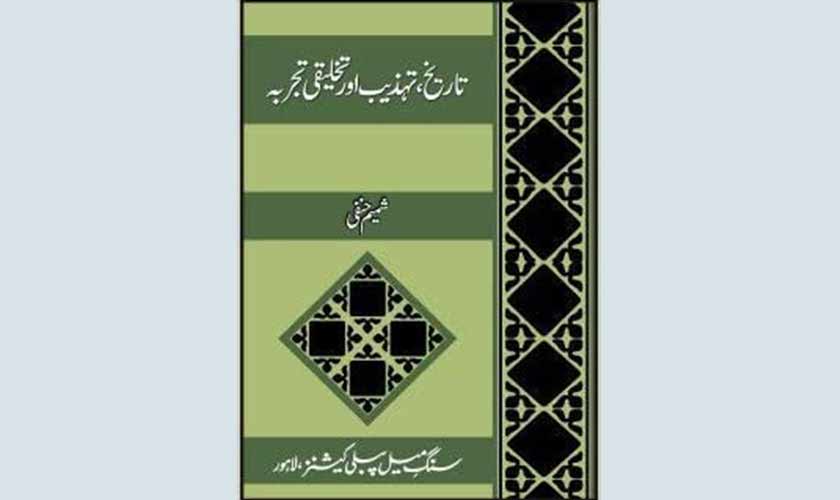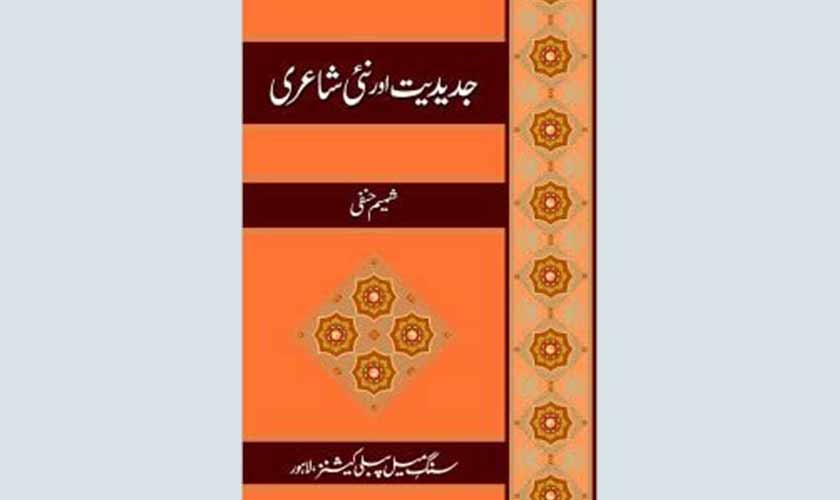https://www.thenews.com.pk/tns/detail/833830-a-literary-giant
Sub-microscopic pathogens are not just lethally destructive but also absolutely mindless and blind. They do not care about who is going to be their next victim. Among the cohort of Urdu writers claimed by the coronavirus pandemic, Shamim Hanfi is the latest. He was equally popular among the Indian and Pakistani literati and readers, Hanfi’s departure is a huge and irreparable loss. Not only have many of Hanfi’s books on criticism been published from Pakistan, but he also frequently visited Lahore and Karachi. He attended almost every edition of the Karachi Arts Council’s Urdu conference as a keynote speaker. The conference is one of the most-awaited events of Pakistan’s literary calendar due to the relentless efforts of Ahmad Shah. Recently, Hanfi participated in a couple of sessions of the Lahore Literary Festival’s online edition.
Shamim Hanfi was born in Sultanpur (Uttar Pradesh), India, on May 17, 1939, in a learned family. His formative years were spent in Allahabad where he completed his education right up to his DPhil. It was in Allahabad that he was inspired by Firaq Gorakhpuri’s person and works. After serving Indore University as a lecturer in Urdu for a while, he joined the Aligarh Muslim University in 1969. In 1976, working under the supervision of Ale Ahmad Suroor, he completed his DLitt thesis titled Jadeediat Ki Falsafiana Asas that established his credentials as a literary critic. The same year, Hanfi left Aligarh to join Jamia Millia, Delhi, where he served as professor of Urdu, dean and director till his retirement in 2007. In recognition of his services to education and literature, he was appointed a professor emeritus by Jamia Millia. He also edited Jamia, the university’s research journal. His literary oeuvre is enviably vast and diverse. He has over 50 books to his credit ranging from criticism to drama, poetry, translation and children’s literature.
Zehr-i-Ishq, the masnavi by Mirza Shauq Lucknavi (1780-1871) was the first major book of poetry he ever read - at the tender age of 9. While the theme did not leave a permanent imprint on his mind, its aesthetics, inundated with plenty of sensual metaphors, did. While he kept reading classical texts of Urdu literature — Meer and Ghalib in particular – his forte was modernist and contemporary literature of Urdu as well as Western and Indian languages. He was not only a well-versed scholar of English, Persian and Hindi, but also a connoisseur of music, painting and theatre. Unlike some contemporary critics, he did not believe in formulating different canons for classical and modern literatures. He held that literariness was where classicism and modernism converged. In Khial ki Masafat, one of his representative works on criticism, he went on to claim that all classical literature of the world is the common heritage of the modern world.
Both his critical and creative writings exhibit his adherence to a particular version of modernism. In his magnum opus Jadeediat Ki Falsafiana Asas, Hanfi seems to have developed that specific version, delineating the schemas of theories and concepts Western modernism is rooted in, Hanfi argues that some enlightening ideas of Zen Buddhism are a marvellous contribution to twentieth-century thought. He was the first Urdu critic to discover a deep-rooted relationship between Buddhist ideas and modern concepts of art. In Jadeediat, he asserts that “Zen is the [perfect] response to the logic of [modern] West. As Zen prioritises daily reality, Hanfi correlates it with existentialism, too. Denying great philosophical theories, existentialism — propounded by the twentieth century Western writers like Heidegger, Camus, Sartre, Karl Bath, Ionesco and Karl Jasper etc – is based on the observing of and reflection on daily, ordinary realities. Hence, it termed as “coffee cup philosophy”. Zen Buddhism also seeks reality by observing daily, ordinary happenings and things. Hanfi called it the Eastern notion of existentialism. Western modernism and existentialism reflect on ordinary and immediate reality through the mediation of language. Zen Buddhism, on the other hand, while encountering daily reality, not only avoids language but considers intervention of the language ‘hazardous’; hence the idea of silence, or s nyat . The specific notion of modernism Hanfi embraced was embedded more in East than West — not because of some essentialist view of culture but because of the artistic significance of the Eastern thought.
Throughout his critical writings, we find him reiterating that “Adeeb ka samna jeeti jagti zindagi say hae’’ (a writer has to encounter the daily reality). This may account for his aversion to retrieving ideas from literary texts. Again, unlike some contemporaries, he detested extracting meaning and then setting on interpreting them in some social, Marxist, historical or psychological perspective. “We don’t read poetry to remember the idea a verse contains, rather it is the lingual and sound image that our mind retains”, he contended. He was also of the view that in poetry the word and the meaning are not distinct or divisible realities. The word per se turns into an image of reality. He contended that “a word doesn’t communicate an idea or thought or some information; but a totality of the poetic experience”. In this context, his dislike of post-modernism, entrenched in linguistic binaries, is understandable.
To him, the act of reading poetry was not social or cultural but personal. Poetry, he said, spoke to our senses, to our soul, to our whole being. In poetry, the divide between body and soul, present and past, becomes redundant. Writing on Zahid Dar in Bazm-i-Hamnafsan, Hanfi went on to assert that insistence on the truth of the body did not entail denial of the soul as it was the body where the soul resided. Furthering the idea of personal engagement with poetry, he claimed that the rebirth of the moment of creativity can take place in the very act of reading. To him, reading poetry was not just seeking something out of it, rather, it was replicating a creative experience. However, he was not oblivious to the fact that creative experience is not just psychological but also embedded in a tehzeeb. He had an aversion to history and psychology and at times would not hesitate to scold those engaged in studying literature in the perspective of extra-literary disciplines. He was all praise for contextualising poetry and fiction in their respective tehzeeb and its values. In this way he appreciated mythology and symbolism and writers like Meeraji and Intezar Hussain whose writings are steeped in mythology.
The Urdu world tamasha perfectly defines the reality of our being in the world… It is short-lived, ephemeral, and dreamlike. So are our lives on this planet. Hanfi sahib has left this tamasha. The tamasha goes on, albeit in an ambience of never-ending sorrow and grief.
We have to bear in mind here that his notion of tehzeeb was not religious or racial – not even secular. It was an imaginative space in which all creative activities were embedded simultaneously; a sum total of all creative experiences that find expression in poetry, fiction, music, pottery, painting and dance. In the preface to Dukan-i-Shishagran — third volume of the trilogy (Hamsafron kay Dramian and Hamnafson ki Bazm mein, being the other two volumes) – he had declared that he could never develop pure scholarly or scientific interest in literature; that his passionate love for art and its (pure) aesthetics left no room for human sciences.
Borrowing from Nigerian poet and novelist Ben Okri’s division between personal and public stories, we can say Hanfi went for the personal ones. He remained sceptical of art’s social and historical role. He thus avoided some pertinent questions regarding the relationship between literature and socially constructed realities.
It was his love for literature rooted in a jeeti jagti zindagi that led him to realise the significance of the writings of Bengali Hungry generation poets, Dalit writers, Black writers, and African and Latin American writers, for all these writers portray their immediate, real, ordinary, existing reality. Hanfi co-edited a book on Siah Faam Adab. In that too, he said that literature produced by the Third World was free from the ideological shackles of the First and the Second Worlds, creating a distinct niche in the history of world literature. Elaborating on the distinctions of black literature, he quoted lines from a black poet: “White races need to nurture a habit of listening while Blacks are required to nourish the habit of speaking (to white).” The courage to speak to White people has been integral to the project of decolonisation. Interestingly, a hint of decolonisation surfaces in his writings. Reviewing a critical edition of Masnavi Gulzar-i-Naseem, edited by Rashid Hasan Khan, Hanfi said that without decolonising our collective taste, character and consciousness, we could not realise the full significance of our past and the sensibility ingrained in our classical works. He was also of the view that until we juxtaposed our classical works with our contemporary sensibility in a bid to reveal their contemporary significance, our engagement with the past was of no value. The present is privileged to determine the value and significance of the past; it hence enjoys a “semantic leverage” to change the past and administer the future course.
Paradox, as a poetic device, has been the backbone of literary modernism. Hanfi’s oeuvre of criticism also harboured a suite of paradoxes. His perception of reality, too, is paradoxical in nature. In Bazaar Mein Neend, his fourth collection of Urdu drama, he quoted Hazrat Ali (with whom Allah was pleased): “People are asleep, they will awake the moment they die”. Thus, the sleep and wakefulness are illusory. It is not just that these states are illusory, but also their meanings. Hanfi held that the reality appearing in art and literature is so weird, dreamlike, illusive and surreal that our intellectual and logical minds fail to grasp it. However, our inner beings can take in the elusiveness of literary reality, for our inner beings themselves nurture contradictions and paradoxes in contrast to our logical minds which do not allow such disorder and consequently any paradox. Being logical, criticism sets out to unravel all paradoxes turning disorder into order. Hanfi’s critical writings avoid being logical and consequently evade unravelling and interpreting paradoxes. He keeps prioritising sensual-surreal assemblage over semantic aspects of the text.
Hanfi loved nature and silence on one hand and cities on the other. A paradox, indeed. Love for nature brought him close to Intezar Hussain and Ram Chandran, the renowned Indian painter; his love for cities to Balraj Manra, the modern short story writer. Writing on the idea of humanism in literature, Hanfi said art and literature sprouted from silence and solitude — another Zen concept. He loved trees, birds, streams and rivers. The city lacking the chirping of birds seemed like a factory to him — a symbol of modern capitalist society that he censured all along. He abhorred noise, breakneck speed, reckless haste, overcrowded bazaars — major characteristics of all modern cities. However, he was cognisant of the Janus-faced charterer of cities. A city is the site of capitalism and tehzeeb alike. Its capitalist and consumerist face causes dehumanisation while the tehzeeb face of it heralds creative activities, shielding city dwellers from dehumanisation. Raat, Shehr aur Zindagi is an anthology of pieces about cities originally written by Hanfi for Balraj Manra’s Shaoor, one of the best Urdu magazines that drew other creative arts into its fold. Other than a noteworthy essay on the city of Calcutta, this book contained four assemblages on Pakistan, Hindustan, Gujarat and Baghdad. The assemblage about Pakistan, focusing on Gen Zia’s regime, particularly on Bhutto’s death and its aftermath, is worth reading not only for its marvellous technique – which features assembling of pieces from contemporary poetry, fiction, history, and newspapers – but also for its significance to us today.
Though less appreciated, Hanfi’s Urdu dramas merit a mention here. His four books of drama, Matti ka Bulawa, Mujhay Ghar Yaad Aata Hae, Zindagi ki Taraf, Bazaar mein Neend, and the anthology Aap Apna Tamashai deal mostly with lives of common people in capitalist, cosmopolitan cities. His dramas Bazaar and Pani Pani are worth mentioning especially. Bazaar, written in the last decade of the 20th century, is about dehumanising of people at the hands of capitalist consumerism. We must put the brakes on, we must slow down, this tamasha must end now — is the gist of the play. Pani Pani, written using the assemblage technique, tells the sad story of South Asia. Its kernel can be subsumed in Coleridge’s famous lines uttered by a nameless character: “Water water everywhere/ but not a drop to drink.” The word tamasha appears repeatedly in all kinds of Hanfi’s writings like a central motif. In Akhri Pehr ki Dastak, his sole anthology of poetry, we come across this verse:
“Zameen say aasman tak apnay honay ka tamasha hae/ Ye saaray silasaly ik lamha-i-fani mein rehtay hain”
[From earth to sky there is just a spectacle of our being in the world. All this concatenation is pinned to ephemerality].
The Urdu world tamasha perfectly defines the reality of our being in the world. Tamasha is the site where real and unreal converge. Though a product of imagination, it is played with high seriousness, putting everything one has at their disposal into it, with intent to give this tamasha some semblance of reality. It is short-lived, ephemeral, and dreamlike. So are our lives on this planet. Hanfi sahib has left this tamasha. The tamasha goes on in an ambience of never-ending sorrow and grief.
I conclude with these lines from a poem by Rabindranath Tagore for whom Hanfi sahib had great regard.
“Farewell, farewell, /my friends, /I smile and bid you goodbye/No, shed no tears, /for I need them not/All I need is your smile/if you feel sad/think of me/for that’s what I’d like”.
The writer is a Lahore-based critic, short story writer, professor of Urdu at University of the Punjab and author of Urdu Adab Ki Tashkeel-i-Jadid , Jadeediat aur Nau Abadiyat (criticism) and Aik Zamaana Khatm Huwa Hai





No comments:
Post a Comment